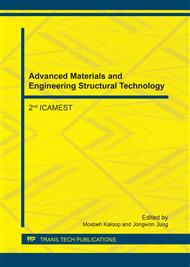[1]
B. S. Xu, Theory and technology of surface engineering, Beijing: National Defend Industry Press, (1999).
Google Scholar
[2]
L. Q. Wang, Corrosion and protection technology of shipping, Zhong Guo Shui Yun. 8 (2008) 20-21.
Google Scholar
[3]
B. Zhang, Y. S. Li, Application of ceramic coatings in the power station equipment, Mod. Manuf. Technol. Equip. 6 (2008) 76-78.
Google Scholar
[4]
B. S. Xu, Z. W. Ou, S. N. Ma, et al. Nano surface engineering, China Mech. Eng. 11 (2000) 707-712.
Google Scholar
[5]
B. S. Xu, H. D. Wang, S. Dong, et a1. Nano surface engineering in the 21st century, Trans. Mater. Heat Treat. 25 (2004) 8-12.
Google Scholar
[6]
B. S. Xu, Remanufacturing engineering and automation of surface engineering technology, Heat Treat. Metals, 33 (2008) 9-14.
Google Scholar
[7]
H. Kim, M. Chen, Q. Yang, et a1. Sol-gel alumina environmental barrier coatings for SiC grit, Mater. Sci. Eng. A. 420(1-2) (2006) 150-154.
DOI: 10.1016/j.msea.2006.01.087
Google Scholar
[8]
M. Handke, M. Sitarz, E. Dlugon, Amorphous SiCxOy coatings from ladder-like polysilsesquioxanes, Mol. Struct. 993(s1-3) (2011) 193-197.
DOI: 10.1016/j.molstruc.2010.12.017
Google Scholar
[9]
W. W. Gong, P. Z. Gao, W. X. Wang, Characterization and oxidation properties of biomorphic porous carbon with SiC gradient coating prepared by PIP method, Ceram. Int. 37(6) (2011) 1739-1746.
DOI: 10.1016/j.ceramint.2011.03.008
Google Scholar
[10]
E. Ediz, S. Ugur, Y. Senol, Structural characterization of plasma sprayed basalt-SiC glass-ceramic coatings, Ceram. Int. 37(3) (2011) 883-889.
DOI: 10.1016/j.ceramint.2010.11.005
Google Scholar
[11]
Y. S. Jang, J. Michael, M. Verena, et al. SiC ceramic micropatterns from polycarbosilanes, J. Eur. Ceram. Soc. 30(13) (2010) 2773-2779.
DOI: 10.1016/j.jeurceramsoc.2010.05.019
Google Scholar
[12]
C. Sophie, L. Sébastien, B. Pierre et al. Surface treatment effects on ceramic matrix composites: Case of a thermal sprayed alumina coating on SiC composites, Surf. Coat. Technol. 205(4) (2010) 1047-1054.
DOI: 10.1016/j.surfcoat.2010.07.021
Google Scholar
[13]
E. Bouyer, G. Schiller, M. Muller et al. Thermal plasma chemical vapor deposition of Si-based ceramic coatings from liquid precursors, Plasma Chem. Plasma Process. 21(4) (2001) 523-546.
Google Scholar
[14]
P. Nadejda, A. Emad, P. F. Andreas et al. Thermal conductivity of porous SiC composite ceramics derived from paper precursor, Ceram. Int. 36(7) (2010) 2203-2207.
DOI: 10.1016/j.ceramint.2010.05.028
Google Scholar
[15]
M. Jayasankar, G. M. Anilkumar, V. S. Smitha et al. Low temperature needle like mullite grain formation in sol-gel precursors coated on SiC porous substrates, Thin Solid Films. 519(22) (2011) 7672-7676.
DOI: 10.1016/j.tsf.2011.05.053
Google Scholar
[16]
Z. M. Fan, X. G. Wang, Y. X. Qiang, Preparation of Al2O3/SiO2 multiphase insulation coating on electric-heating porous SiC ceramics, J. Xi'an Univ. Sci. Technol. 28 (2008) 72-75.
Google Scholar
[17]
Z. F. Xie, S. R. Wang, Z. H. Chen, Active filler (aluminum–aluminum nitride) controlled polycarbosilane pyrolysis, J. Inorg. Organomet. Polym. 16(1) (2006) 69-81.
DOI: 10.1007/s10904-006-9030-2
Google Scholar
[18]
D. X. Yang, Y. X. Yu, P. Xiao et al. Fabrication of silicon carbide (SiC) coatings from pyrolysis of polycarbosilane/aluminum, J. Inorg. Organomet. Polym. 21 (2011) 534-540.
DOI: 10.1007/s10904-011-9481-y
Google Scholar
[19]
P. Xiao, D. X. Yang, Novel chemical method tofabricate SiC/Al2O3 ceramic composite coatings on metallic substrates, China Surf. Eng. 22 (2009) 24-29.
Google Scholar
[20]
S. Zhu, B. S. Xu, J. K. Yao, High quality ceramic coatings sprayed by high efficiency hypersonic plasma spraying gun, J. Mater. Sci. Forum. 475-479 (2005) 3981-3984.
DOI: 10.4028/www.scientific.net/msf.475-479.3981
Google Scholar
[21]
B. S. Xu, Z. X. Zhu, W. Zhang et a1. Sliding wear behavior of Fe-Al and Fe-A1/WC coatings prepared by high velocity arc spraying, Wear. 257(11) (2004) 1089-1095.
DOI: 10.1016/j.wear.2004.05.012
Google Scholar
[22]
B. S. Xu, W. Zhang, W. P. Xu, Influence of oxides on high velocity arc sprayed Fe-A1/Cr3C2 composite coatings, Centr. South Univ. Technol. 12(3) (2005) 259-262.
DOI: 10.1007/s11771-005-0139-1
Google Scholar
[23]
C. Wu, Y. L. Xi, Q. H. Wang, Preparation technology of nano-ceramic coatings, Dev. Appl. Mater. 25 (2010) 94-98.
Google Scholar
[24]
S. Yajima, X. Hasegawa, J. Hayashi, et al. Synthesis of continuous SiC fibers with high tensile strength and modulus, J. Mater. Sci. 13(12) (1978) 2569-2576.
DOI: 10.1007/bf02402743
Google Scholar
[25]
S. Yajima, X. Hasegawa, M. Omori, et al. Development of a SiC fibers with high tensile strength, Nature. 261 (1976) 683-685.
Google Scholar
[26]
X. J. Ding, J. Z. Zhang, J. J. Li et al. Spray-Dried Alumina Granules for Extrusion, J. Inorg. Mater. 16(6) (2001) 1094-1100.
Google Scholar


